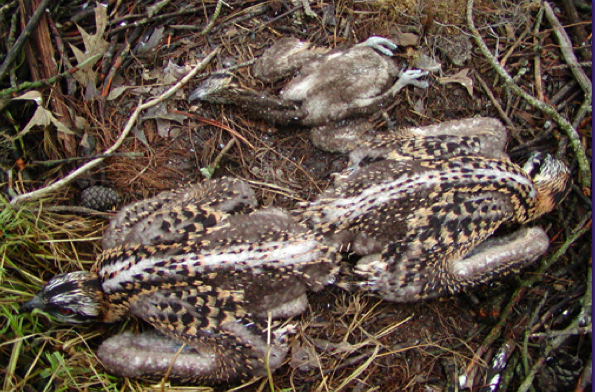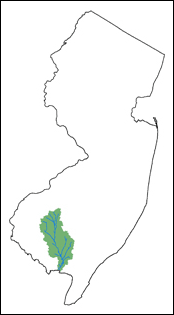|
Maurice River Recollections Project
Osprey Nest Anecdotes
Bricksboro Lawrence
This nest is named for the village of Bricksboro, presently a neighborhood, but at one time a thriving enclave. The village was situated across from where the platform now stands. The town was the namesake of its founder Joshua Brick. There were sundries and ship stores and it was an active little community. It was Jack Lawrence who asked that we put the structure there. He also lent his boat to the construction project. Jack and his neighbor Mary Lou Barbose are vigilant in watching this nest and report osprey arrivals and any problems. At this nest, we had one of the most unusual occurrences take place. In 2003, we found an adult female dead on top of two live chicks and one dead one. We turned in the carcass for necropsy and the band number to the USGS service. We were concerned because it was a cold, wet, dismal spring for osprey and we were finding chicks starved in the nest. From the band it was determined the adult was an eight-year-old female who had choked to death. The bird had also been fledged a few watersheds northwest in Canton by a colleague, Ted Nichols of NJ Fish and Wildlife. When we later returned to band the chicks, as they were too young for banding on the previous visit, we found the male had raised two healthy chicks that subsequently fledged, thus showing it is possible for an adult osprey to raise the chicks on its own. However, it could not have been an easy task and would take an experienced bird. Had the chicks been one week younger they would likely have perished from exposure. A clutch of three can consume six pounds of fish a day! In fact, the dead chick died of starvation. Chicks are fed in the order in which they are born and as such, the youngest chick is fed when the oldest has had its fill. Thus, it is not uncommon for the youngest to starve if food is in short supply.
Three chicks about the same age, but one is starved to death, first laid is first fed Closest River Reach: Brickboro http://www.cumauriceriver.org/reaches/pg/narratives.cfm?sku=31 |
Osprey Colony Project
Introduction Welcome to Citizens United's River Recollections Project. These stories are but a few of my memories associated to osprey nesting structures along the Maurice River and its tributaries. It is part of a larger project including an interactive map of the of river reach lore, live campfire recollection events, documentaries, presentations and archives held by the organization. I believe the greatest connection that people have to a river is the sharing of their bond to it through the telling of stories. These stories are accurate accounts from my perspective the truth, as I know it. The stories are designed to give you insight into some life history of the osprey but are primarily designed to give you a flavor for being an osprey volunteer. Over 150 volunteers have been involved in the construction of the osprey platforms. Sincerely,
|

 If you enjoy these stories or have a love of history, you may find visiting our interactive River Reach Map, which allows you to explore cultural aspects of the Maurice River's tidal reaches, simply click on buoys to begin your voyage.
If you enjoy these stories or have a love of history, you may find visiting our interactive River Reach Map, which allows you to explore cultural aspects of the Maurice River's tidal reaches, simply click on buoys to begin your voyage.